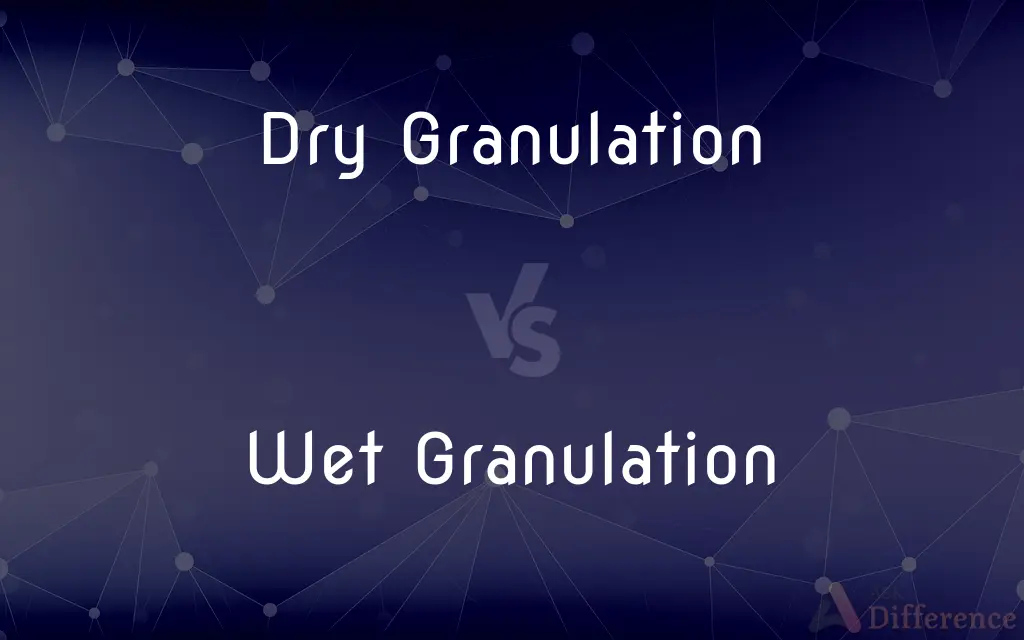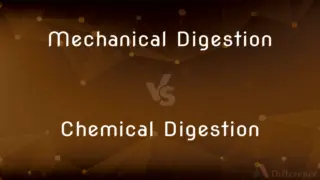Dry Granulation vs. Wet Granulation — What's the Difference?
Edited by Tayyaba Rehman — By Fiza Rafique — Published on December 11, 2023
Dry Granulation uses no liquid, while Wet Granulation requires liquid binders.

Difference Between Dry Granulation and Wet Granulation
Table of Contents
ADVERTISEMENT
Key Differences
Dry Granulation is a method where powder particles are aggregated without using any liquid solution. It relies on mechanical methods to form granules. Wet Granulation, on the other hand, involves the use of a liquid binder or solvent to promote particle adhesion. This liquid aids in the cohesion and agglomeration of particles, leading to the formation of granules.
In Dry Granulation, the key processes might include compacting and densifying the powders. This method is suitable for materials that are sensitive to moisture or heat. Wet Granulation, contrastingly, requires drying processes post-agglomeration, making it unsuitable for heat-sensitive products.
While Dry Granulation is generally considered simpler and more cost-effective due to the absence of drying and liquid addition steps, Wet Granulation is known to produce granules with better flow and compressibility properties. This can be a deciding factor based on the intended use of the granules.
Dry Granulation often employs roller compaction or slugging as the primary technique. This approach can mitigate the issue of dust generation, which can be a concern in certain industries. Wet Granulation, meanwhile, can lead to more uniform particle size distribution, a factor that can influence the final product's quality and performance.
One significant challenge in Dry Granulation is achieving uniform granule size, as there's no liquid to assist in the process. In contrast, Wet Granulation may introduce complexities related to the selection of a suitable binder, drying conditions, and potential changes in the drug's stability or solubility.
ADVERTISEMENT
Comparison Chart
Use of Liquid
No liquid used
Requires liquid binders
Process Complexity
Generally simpler
Might need drying steps
Suitability
For moisture/heat-sensitive materials
Not for heat-sensitive products
Granule Properties
Can have varied size distribution
Often more uniform particle size
Common Techniques
Roller compaction, slugging
Addition of binder, drying
Compare with Definitions
Dry Granulation
A method avoiding moisture in granule creation.
Their preference for Dry Granulation ensures moisture-sensitive ingredients remain intact.
Wet Granulation
Process involving drying post-agglomeration.
After the Wet Granulation step, a drying phase is essential.
Dry Granulation
Particle cohesion through compaction or slugging.
For this product, Dry Granulation proves most efficient.
Wet Granulation
Often results in uniform particle size distribution.
The uniformity achieved is thanks to the Wet Granulation technique.
Dry Granulation
Aggregation technique using mechanical methods.
The factory uses Dry Granulation for its powder products.
Wet Granulation
Granulation using liquid binders or solvents.
The pills were manufactured using Wet Granulation.
Dry Granulation
Granulation that typically results in varied particle sizes.
Dry Granulation can produce uneven granule sizes in certain scenarios.
Wet Granulation
A method promoting particle adhesion through moisture.
Wet Granulation aids in achieving consistent granule forms.
Dry Granulation
A process forming granules without liquid.
The medicine was produced through Dry Granulation.
Wet Granulation
Technique producing granules with better flow properties.
For better flowability, they opted for Wet Granulation.
Common Curiosities
Is particle size distribution uniform in Dry Granulation?
Dry Granulation might result in varied particle size distribution.
Why would one choose Wet Granulation over Dry Granulation?
Wet Granulation can produce granules with better flow and more uniform particle sizes.
What is Dry Granulation?
Dry Granulation is a process where granules are formed without using any liquid solution.
Which granulation process avoids the use of liquid?
Dry Granulation avoids using any liquid.
What's a common technique in Dry Granulation?
Roller compaction is a common technique in Dry Granulation.
Why might one opt for Dry Granulation?
Dry Granulation is simpler, cost-effective, and suitable for moisture-sensitive products.
How is Wet Granulation different from Dry Granulation?
Wet Granulation involves the use of a liquid binder, whereas Dry Granulation does not.
Which granulation method is more suitable for heat-sensitive products?
Dry Granulation is more suitable for heat-sensitive products.
What challenges might one face in Wet Granulation?
Selecting a suitable binder and ensuring stability during drying are challenges in Wet Granulation.
Can Dry Granulation mitigate dust generation?
Yes, Dry Granulation can reduce dust generation in certain contexts.
Which granulation method might produce better compressibility properties?
Wet Granulation is known for better compressibility properties.
Does Wet Granulation require a drying process?
Yes, Wet Granulation usually requires a post-agglomeration drying process.
How do granules form in Wet Granulation?
In Wet Granulation, liquid binders promote particle adhesion to form granules.
Which method might lead to more complexities in production?
Wet Granulation might introduce complexities due to binder selection and drying conditions.
Are there any binders used in Dry Granulation?
No, Dry Granulation typically doesn't use binders.
Share Your Discovery

Previous Comparison
Altered vs. Changed
Next Comparison
Mechanical Digestion vs. Chemical DigestionAuthor Spotlight
Written by
Fiza RafiqueFiza Rafique is a skilled content writer at AskDifference.com, where she meticulously refines and enhances written pieces. Drawing from her vast editorial expertise, Fiza ensures clarity, accuracy, and precision in every article. Passionate about language, she continually seeks to elevate the quality of content for readers worldwide.
Edited by
Tayyaba RehmanTayyaba Rehman is a distinguished writer, currently serving as a primary contributor to askdifference.com. As a researcher in semantics and etymology, Tayyaba's passion for the complexity of languages and their distinctions has found a perfect home on the platform. Tayyaba delves into the intricacies of language, distinguishing between commonly confused words and phrases, thereby providing clarity for readers worldwide.
















































